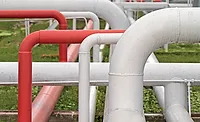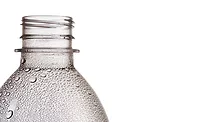Waterborne Polyurethane Dispersions with New Sustainable Solvent

Credit: Taminco
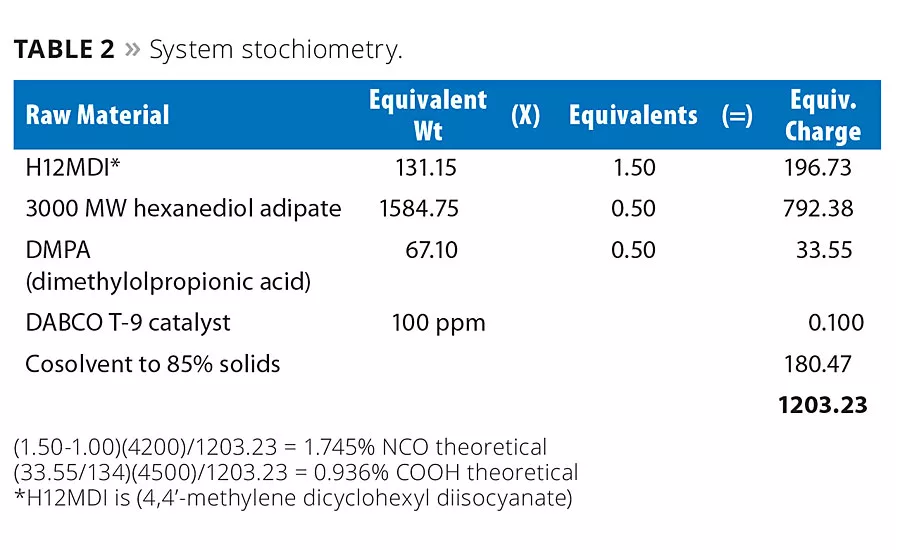
Credit: Taminco
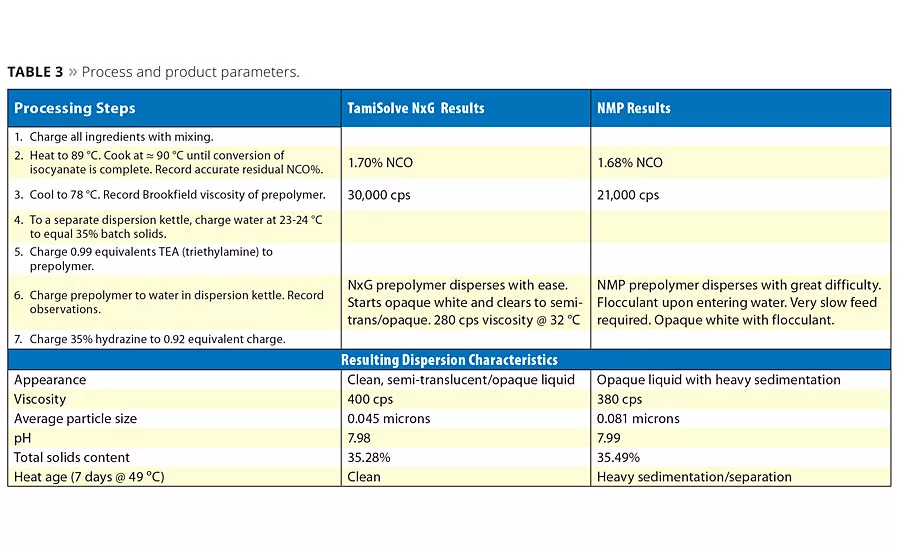
Credit: Taminco
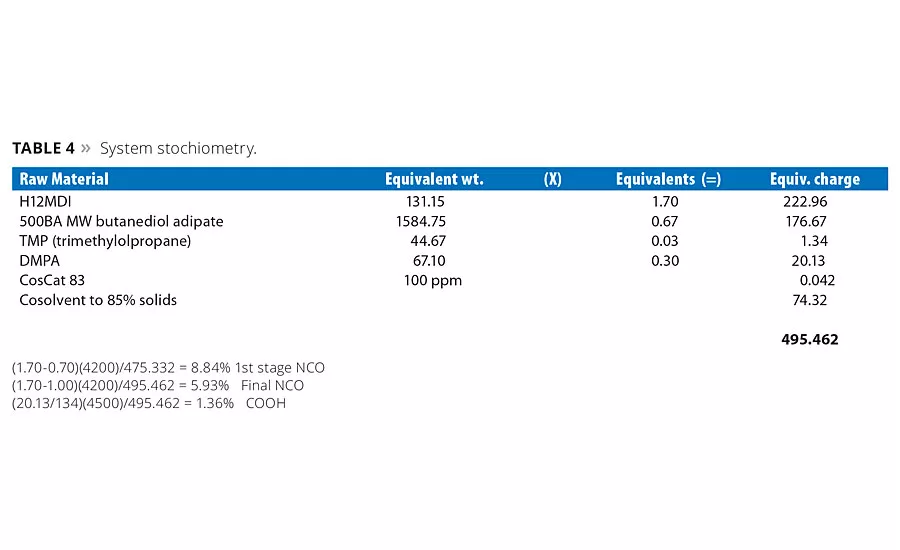
Credit: Taminco

Credit: Taminco

Credit: Taminco
The uniquely functional cosolvent N-methyl-pyrrolidone (NMP) iswell suited for use in waterborne polyurethane dispersions (PUDs). The use of cosolvents during polyurethane dispersion production is often necessary to enable a smooth reaction between the hydrophilic diol components [e.g., dimethylolpropionic acid (DMPA)] and the more hydrophobic polyurethane prepolymer. In addition, the cosolvent used during the PUD production phase remains in the system and later becomes a useful coalescing solvent when the PUD is applied as a coating to a substrate. The utility of NMP is diminished by the negative health effects of NMP exposure, and for many years the industry has sought an effective and safer substitute for NMP. Taminco, now a subsidiary of Eastman Chemical Company, has identified and developed the needed replacement, TamiSolve® NxG. It is a more effective cosolvent than NMP and it also exhibits an improved Health, Environment and Safety (HES) profile relative to NMP.
HES Profiles
Waterborne PUDs are used as coatings, adhesives, sealants and elastomers. Waterborne PUD-based coatings display excellent adhesion to challenging substrates like plastic and metal. Dried/cured PUD coatings have excellent mechanical properties and environmental resistance, and waterborne PUD-based coatings are becoming the coatings of choice for demanding applications like floor coatings, as well as those used in industrial environments. Application of waterborne PUD coatings and adhesives can expose the applicator to volatile compounds that are emitted from the formulation. Therefore, the HES profile of the formulation’s ingredients is very important. In addition, the atmosphere is also exposed to the VOC content emitted from an applied PUD-based coating and/or adhesive. Obviously, the use of safer solvents, and in lower amounts, markedly improves the HES profile of a given PUD-based product.
A summary of the HES profile of Tamisolve NxG is provided in Table 1. Testing has shown that this new solvent has a good environmental impact profile and does not display genotoxicity. Most importantly, unlike NMP and NEP, TamiSolve NxG is not classified for developmental toxicity. Replacing NMP or NEP with TamiSolve NxG can reduce the overall health and environmental impact of cosolvent in a polyurethane dispersion formula.
Performance in PUDs
Reduced Water Solubilizing/Dispersing Entity Needed
The high solvency of TamiSolve NxG for polyurethane prepolymers delivers excellent processing and dispersion of the prepolymer into the water phase. The high solvency coupled with its water dispersibility as a cosolvent significantly aids in the dispersion of the polyurethane solids in water. The effects are far superior to NMP, and, in many cases, NxG will allow for a significant reduction in the required amount of hydrophilic entity content (e.g., dimethylolpropionic acid, DMPA) in the polymer backbone. This can provide unique formulation flexibility that is not available when using NMP or NEP. Also, the use of this product provides formulation cost advantages since more expensive DMPA-type monomers can be replaced with a lower-cost option.
To demonstrate the improved processing afforded by TamiSolve NxG and its ability to reduce the required level of DMPA for acceptable dispersion, two equivalent polyurethane preparations were made. One used TamiSolve NxG as a cosolvent and the second used NMP. A description of these comparative systems and the resulting process and product parameters are shown in Tables 2 and 3.
As noted in these two tables, the NxG-based polyurethane prepolymer was easy to produce and showed a clean, semi-translucent appearance, while the NMP-based prepolymer was more difficult to disperse and showed heavy flocculation. These results demonstrate that polyurethane prepolymers, using the new dispersion solvent, can be made at lower levels of DMPA compared to those using NMP as a solvent.
Enhanced Coalescence
Tamisolve NxG offers exceptional solvency for both polyurethane prepolymers and fully formed PUD backbones. Compared to NMP and NEP, it offers significantly improved coalescence of PUD films, and this can enable significant VOC reduction due to the lower cosolvent demand for a required degree of coalescence. Due to its improved coalescing ability, formulators may now use alternative, less-objectionable coalescing cosolvents in conjunction with TamiSolve NxG. This gives formulators more flexibility in formulating to achieve optimal dry times and application properties. Even when equal levels of NxG, as compared to NMP or NEP, are used, the NxG systems still exhibit more rapid comparative dry to touch times with exceptional solvency and improved film formation.
To demonstrate the improved solvency, three equivalent polyurethane preparations were made. One used NxG as a cosolvent and the other two used NMP and NEP respectfully. A description of these comparative systems and the resulting process and product parameters are shown in Tables 4 and 5.
Because each of the above systems demonstrated poor coalescence at RT as manufactured, it was shown that not enough solvent was present. To determine the comparative amount of test cosolvent that is required to achieve coalescence of the PUD backbone when applied at 10 wet mil film and dried at 20 ºC, appropriate cosolvent was back added to each system. A description of these comparative systems and the resulting product parameters are shown in Table 6.
The experimental data in Table 6 demonstrates that, whether used as the sole solvent or in combination with another cosolvent, PUD formulations with NxG show improved coalescence compared to formulations made with NMP or NEP. The data also shows that NxG allows for well-coalesced films at lower total solvent levels.
Conclusions
TamiSolve NxG is a true process equivalent to NMP, the benchmark for PUD cosolvent performance. It is supplied with polyurethane-grade moisture content and offers a clean/pure reaction medium that is free of polyisocyanate-reactive contaminants. NxG has low vapor pressure, and high flash and boiling points for processing that allows normal polyurethane cook temperature cycling and high exotherm processing (if desired). Just like NMP, it offers very slightly basic curing conditions that gently enhance the reactivity of the polyisocyanate. And it demonstrates excellent solvency for DMPA, yielding smooth dissolution and subsequent reaction. The comparative viscosities of NxG-containing prepolymers are typically higher than the equivalent NMP-based systems. Unlike the plasticizers and glycol ethers, it is a true processing match for NMP.
The new solvent demonstrates no permanent plasticizing effects beyond what would be considered normal for an NMP-based system. Due to the strong solvent coupling effect of NxG, systems produced using it will demonstrate a slightly slower hardness development upon air dry compared to NMP and NEP. Hardness differences are minimal but, in general, the NxG-based system will produce a film that reaches the equivalent hardness of a film produced by a “normal” NMP system in three days via air dry. After this slightly extended drying time, the NxG-based film will demonstrate superior hardness development compared to NMP. With an oven dry cycle, the NxG yields superior film hardness immediately when compared to an NMP-based equivalent system.
This new product is an innovative, next-generation sustainable solvent with excellent performance in a wide variety of waterborne PUD applications. It offers an improved safety, health and environmental profile compared to the traditionally used solvents NMP and NEP. NxG, NMP and NEP have been tested in PUD systems. The results of these tests show NxG provides similar viscosity control, improved coalescence ability and improved dispersibility of the final PUD system. NxG provides formulators the ability to reduce the solubilizing comonomer content (e.g., the amount of DMPA used) and/or the total cosolvent content while maintaining or improving the end-use properties of the PUD. It now gives PUD chemists the ability to formulate reduced VOC systems with equivalent or superior film formation, similar dry times and, in many cases, enhanced physical properties due to improved film formation and dispersibility.
For more information, visit www.tamisolvenxg.com.
Author’s Note: Special thanks to HABBCo Industries, LLC for their help preparing and testing the polyurethane dispersions presented in this paper.
Looking for a reprint of this article?
From high-res PDFs to custom plaques, order your copy today!





